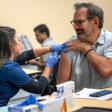
Fabrice Beretta, MBA, offers his perspective on CTSI’s Planning, Evaluation and Tracking (PET) effort, including challenges, opportunities, and what he likes most about his job. He also shares his passion for swimming with sharks.
Q: As director of CTSI’s Planning, Evaluation and Tracking (PET) initiative, what’s the goal of the work you’re involved in?
A: The goal is twofold. First, to demonstrate the value CTSI generates to our stakeholders, including UCSF, the community and the NIH. And second, to deploy and build tools and best practices to achieve Clinical and Translational excellence; essentially accelerating research to improve health in the community.
Q: What are some of the challenges facing CTSI that the PET program is in a good position to address?
A: One key challenge facing CTSI is to maintain its ability to multi-task, a skill that the group is expert at and that has generated a lot of success. CTSI feels very much like a startup. But in order to not fall into the trap that many startups fall into—taking on too much with limited resources—we need to simultaneously develop robust resource planning and execution tools to further expand reach and activities. In that context, prioritization and the discerning use of resources become key. This is where PET adds value because it has the skillset and experience to partner with each program to quantify the impact of efforts with metrics methodology and estimate the ROI for different activities. This will help program managers make sound decisions about where to best allocate resources.
Q: What’s your vision for this program a few years down the road?
A: The vision for this group is to develop superior processes, technologies, and the skillset needed to support the Institute’s and UCSF’s goals. We need strong planning and performance management processes, as well as robust and user-friendly technologies to enable these processes. And the most important part involves the skillset. To achieve Clinical and Translation Excellence, we need high-performing teams of experts from diverse fields, including scientific and business fields, and I see PET playing an integral role in providing the tools to these teams to maximize performance.
Q: We’re still getting used to working with the Balanced Scorecard, a relatively new tracking and measurement system at CTSI. Can you briefly describe how it works, and specific benefits that this approach has for the Institute.
A: The principles of the Balanced Scorecard are simple: to help an organization or a team determine WHAT objectives need to be accomplished, and HOW these objectives are going to be achieved and measured. First, one looks at the gaps between current and expected performance. The WHAT then becomes a list of objectives to fill these gaps. The HOW is then a list of initiatives to meet these objectives, along with their associated metrics. The term “balanced” simply refers to ensuring that gaps are filled in all aspects of a business: meeting customer demands (in CTSI’s case the UCSF, NIH and the community), running efficient processes, and relying on a sound business model.
Q: You worked at Genentech before coming to CTSI. What are some things that industry does well in your area of expertise that we can learn from?
A: The biotech/pharmaceutical industry, and Genentech in particular, has developed very effective planning, project management, and decision-making tools grounded in scientific and business data. This allows executives and managers at all levels of an organization to make informed decisions about prioritizing resources, delivering sound execution of business plans, and effectively mitigating risks. You can’t plan for everything, but the better the planning we have the more effectively we can react to unforeseen circumstances. The ultimate objective is to deliver planned, predictable performance. I’m confident that we can take the essence of this philosophy, seed it into the academic system, and see results!
Q: You have been at CTSI for several months now. What do you like most about your job?
A: I like the fact that I can experience what it feels like to be in a cool startup. There is a critical mass of talent and creative people here, along with great management and resources. You can really feel the sense of opportunity that comes when these ingredients are combined, and that is energizing.
Q: What’s something that your colleagues may not know about you?
A: That I once dove with dozens and dozens of sharks—including a 15-foot tiger, 170 feet deep in Rangiroa, one of the largest Atolls in French Polynesia. There is a pass there where they congregate in such numbers that local divers call this spot “the wall”—of sharks. The combination of the depth and being in the middle of so many sharks—they looked like passing ghosts coming from and disappearing into the blue—was the most surreal experience I’ve ever had!




